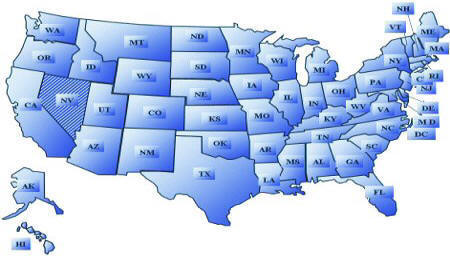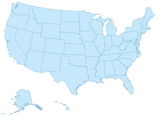Different regions of California have very different climates, depending on their latitude, elevation, and proximity to the coast. Most of the state has a
Mediterranean climate, with rainy
winters and dry
summers. The influence of the ocean generally moderates temperature extremes, creating warmer winters and substantially cooler summers, and the cold oceanic California Current offshore often creates summer fog near the coast. As one moves away from the coast, the climate becomes more
continental, with colder winters and markedly hotter summers. The temperature gradient between immediate coast and low-lying inland valleys in the north is about 7 °F (4 °C) in winter, coast being warmer, and in summer roughly 25 °F (14 °C) but opposite. In the south, the figures are approximately 4 and 23 °F (2 °C and 13 °C), respectively; however 4 °F and 35 °F (2 °C and 20 °C) between
Santa Barbara and
Death Valley.
Westerly winds from the ocean also bring moisture, and the northern parts of the state generally receive higher rainfall than the south. California's mountain ranges influence the climate as well: moisture-laden air from the west cools as it ascends the mountains, dropping moisture; some of the rainiest parts of the state are west-facing mountain slopes. Northwestern California has a temperate climate with rainfall of 15-40 inches (400-1000 mm) per year. The Central Valley has a Mediterranean climate, but with greater temperature extremes than the coastal areas; parts of the valley are often filled with thick fog, similar to that found in the coastal valleys. The high mountains, including the Sierra Nevada, have a mountain climate with snow in winter and mild to moderate heat in summer.
On the east side of the mountains is a drier "rain shadow." California's desert climate regions lie east of the high Sierra Nevada and southern California's Transverse Ranges and Peninsular Ranges. The low deserts east of the southern California mountains, including the Imperial and Coachella valleys and the lower Colorado River, are part of the Sonoran Desert, with hot summers and mild winters; the higher elevation deserts of eastern California, including the Mojave Desert, Owens Valley, and the Modoc Plateau, are part of the Great Basin region, with hot summers and cold winters.
Death Valley, in the northern portion of the Mojave Desert on the east side of the state, is the hottest spot on the Western Hemisphere, with high temperatures over 120 °F common in the summer. The highest temperature in the Western Hemisphere, 134 °F (56.6 °C), was recorded in Death Valley on July 10, 1913. Temperatures of 130 °F or higher have been recorded as recently as 2005. The 24-hour average July temperature in Death Valley is 101 °F (38 °C) (1961--1990 standard).


